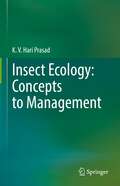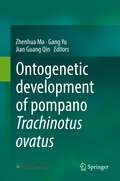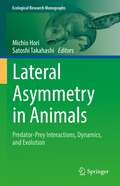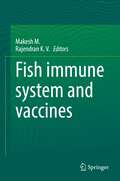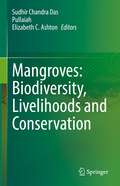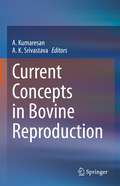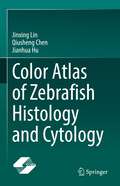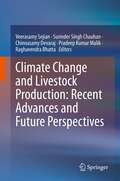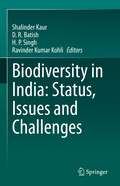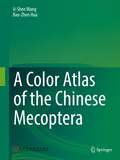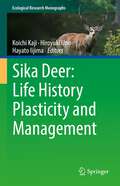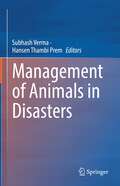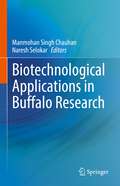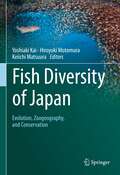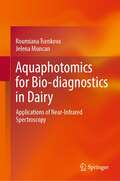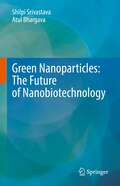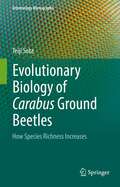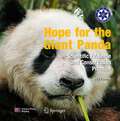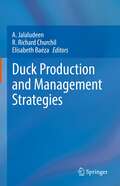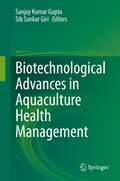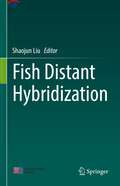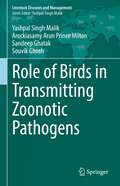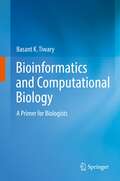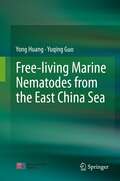- Table View
- List View
Insect Ecology: Concepts to Management
by K. V. PrasadThis book presents comprehensive information on various aspects of ecology with special reference to insects, to form a platform to design an ecologically sound insect pest management. Insects are the most dominant and diverse group of living organism on earth. Owing to their smaller size, smaller space and food requirements, more number of generation per unit time, insects serves as one of the best subject matter for studies on various ecological aspects such as chemical ecology, population dynamics, predator/parasitoid-prey interactions etc. The knowledge on various aspects of insect ecology helps in formulating an effective environmentally benign insect pest management. This book is of interest and use to the post graduate students and researchers working on various aspects of insect ecology with special emphasis on population dynamics, chemical ecology, tri tropic interactions, ecological engineering and Ecological Insect pest management.
Ontogenetic development of pompano Trachinotus ovatus
by Zhenhua Ma Gang Yu Jian Guang QinThis book highlights the ontogenetic development of larval T. ovatus, provides a comprehensive overview of larval rearing of this species. It focuses on the physiological and molecular changes during the early ontogeny of T. ovatus and hatchery and nursery practices. The first seven chapters update the recent development in the hatchery technology in T. ovatus, including feed and feeding, environmental manipulation, hatchery management, and fingerlings in transportation. Chapter eight and onwards decode the possible molecular mechanisms underlying fish development and response to environmental changes and discuss the transcription and expressions of growth and development-related genes in T. ovatus. The last chapters discuss the functional feed additives to the diet and antibiotic usage of T. ovatus juveniles. This book is a valuable resource for researchers, practitioners and students in the aquaculture industry and related fields.
Lateral Asymmetry in Animals: Predator-Prey Interactions, Dynamics, and Evolution (Ecological Research Monographs)
by Satoshi Takahashi Michio HoriThis book presents the latest research findings on the laterality of fish and other animals. It describes all aspects of lateral asymmetry, including ecology, morphology, behaviour, dynamics of lefty and righty morphs, genetics and evolution, through field observations, experiments and modeling. Lateral asymmetry in scale-eating cichlids gives a simple and beautiful example of negative frequency-dependent selection and resulting oscillation of lefty and righty morph frequencies. Lateral dimorphism is found not only in scale-eaters but in all orders of fish, shrimps and cuttlefish. Lateral asymmetry interacts between species through "cross-predation." Contrary to fish, lateral asymmetry in snails acts as, in most cases, positive frequency-dependent selection and provides deep insights into speciation. Especially, snakes eating righty snails facilitate speciation of lefty snails.As a collaboration work of field ecologists and theoretical biologists, this book covers a variety of topics on lateral asymmetry, which are consistently related to predation. The topics include behavioral ecology, population dynamics, physiology, evolution, genetics, development, learning and neuroscience, statistics, with the subjects of fish, shrimp, prawn, and crayfish, crab, cuttlefish, and snake and snail. Chapters cover new research results such as cuttlefish laterality dynamics, interaction between laterality of snails and snakes, evolution of laterality genetic system, and statistical analysis of laterality oscillation. Readers will appreciate the simplicity and beauty of lateral asymmetry and its profound impact on ecology and evolution.
Fish immune system and vaccines
by M. Makesh K. V. RajendranThis book is a collection of comprehensive and latest information on all aspects of vaccination in fish and shellfish. It provides the basic understanding about the immune system of both fish and crustaceans, besides giving the latest information on adjuvants, vaccine delivery methods, adverse effects of vaccines and methods to assess the efficacy of vaccines. Separate chapters on the role of pattern recognition receptors and interferons in fish vaccination, biofilm vaccines and biosafety and regulatory requirements for fish vaccines are also included. Aquaculture, being the fastest growing food producing industry in the world, is looked upon for alleviating the malnutrition especially among the under privileged population. However, intensive aquaculture practices have led to increased incidences of diseases and significant production losses. Among various health management measures employed in aquaculture, vaccination has been proven to be the best approach to protect fish against pathogens. It is considered to be safe and is a key factor for sustainable aquaculture. In this background, apart from the basic understanding of fish and shellfish immune system, updated knowledge on various types of vaccines and the vaccination strategies currently employed in aquaculture are also covered. The book is designed to provide the latest and comprehensive knowledge on all these aspects as a compiled resource material which is useful to students, researchers and other professionals in the field of aquaculture.
Mangroves: Biodiversity, Livelihoods and Conservation
by Sudhir Chandra Das Pullaiah Thammineni Elizabeth C. AshtonThis contributory volume is a comprehensive collection on the mangrove forest eco-system and its ecology, the resources and potentials of mangroves, conservation efforts, mangrove eco-system services and threats to conservation. The book is an all-inclusive compilation on the status, conservation and future of mangroves. Mangroves are a unique ecosystem providing several ecosystem services. They are formed in the inter-tidal areas of large rivers and coastal islands. Mangroves thrives due to constant interaction with the terrestrial and marine ecosystem. These are the species dynamics, varying tidal amplitudes, plant succession, changing floral pattern of the channels of the estuary, the varying sediment transportation. There was 20% decline in mangrove forest area in the last 25 years due mainly to conversion and coastal development. Lengthy recovery periods required for the degraded mangrove forests. Hence there is an urgent need to take stock of the updated information on these mangroves at global level. It is of immense value to scientific community involved in teaching, research and extension activities related to mangrove conservation.
Current Concepts in Bovine Reproduction
by A. Kumaresan A. K. SrivastavaThis book provides updated information on the current concepts in bovine reproduction. It describes the complex issues associated with fertility and infertility in bovines and suggests strategies for achieving high reproductive efficiency. It discusses topics related to the fertility trend in bovines, estrus detection, controlled breeding, postpartum uterine health, uterine infections, and its therapeutic management. The essential roles of metabolic hormones on gonadal functions and fertility are also covered. Additionally, the book presents new insights in maternal recognition of pregnancy in bovines and suggest nutritional strategies to improve reproductive efficiency. The chapters on male fertility provide current information on semen cryopreservation, sperm quality assessment and measures to improve sperm fertility. A special chapter on intricacies in buffalo semen cryopreservation and measures to improve the quality of cryopreserved sperm is also included in this book. Lastly, the book introduces the immunobiological roles of anti-microbial peptides during sperm transport in reproductive tract and epigenetic bearing on fertility. This book is an invaluable resource for veterinary scientists, students and practitioners to understand the current developments in bovine reproduction for improving reproductive efficiency.
Color Atlas of Zebrafish Histology and Cytology
by Jianhua Hu Jinxing Lin Qiusheng ChenThis book elucidates the tissue structure and cell composition of the organs of zebrafish at the microscopic, ultrastructural and molecular levels. The distribution of important macromolecular substances is shown and the morphological relationship between different components is analyzed. The book is divided into 15 chapters and contains more than 700 structural photos, all of which are original experimental pictures of the research group. It shows the histological panorama of the whole zebrafish both in cross and longitudinal sections and covers and interprets the tissues and organs of zebrafish in detail, including oropharynx, taste buds, pharyngeal teeth, liver, etc. A brief text description of the structure and function meaning is available for every picture to facilitate the audience understanding the theoretical knowledge more vivid and concrete. In addition, the 3D reconstruction of the main organs of zebrafish is completed by computer-aided technology, and the three-dimensional morphology of the organs is displayed in an intuitive form. This book provides a reference for postgraduates and researchers in anatomy, biology, animal medicine, animal science, aquaculture, developmental biology, medicine, and experimental animals.
Climate Change and Livestock Production: Recent Advances and Future Perspectives
by Veerasamy Sejian Surinder Singh Chauhan Chinnasamy Devaraj Pradeep Kumar Malik Raghavendra BhattaThis book describes the importance of sustainable livestock production from a food security perspective in the changing climate scenario. It covers the amelioration of climate change impacts and describes the various mitigation strategies to reduce enteric methane emissions. The book targets sustainable livestock production by covering diverse concepts of amelioration, mitigation, and policy up-gradation. Further, it examines various adverse impacts of climate change on growth, meat, milk, and reproduction in livestock. Most importantly, the book covers novel aspects of quantifying heat stress response of livestock based on non-invasive methodologies, including infrared thermal imaging, sensor-based applications, hair, urine, and fecal cortisol estimation. Particular emphasis was given to describing the skin-based novel approaches to establish climate resilience in indigenous breeds. The book provides detailed descriptions of alleviating climate change impacts on shelter management, nutritional interventions, and genetics-based strategies involving advanced genomic tools. Lastly, it highlights the livestock species which could be considered ideal climate-resilient animal models to withstand the adversities associated with climate change.
Biodiversity in India: Status, Issues and Challenges
by Shalinder Kaur D. R. Batish H. P. Singh Ravinder Kumar KohliThis contributed book is based on the current status of biodiversity in India, issues and challenges faced by the authorities involved in conservation efforts, and the imperative role of various direct and indirect stakeholders in biodiversity conservation. The book discusses the current status of different forms of biodiversity in India, challenges faced by stakeholders, issues and reasons for biodiversity losses, and efforts by government through various laws, policies, and programs in a concise and comprehensive manner throughout its many chapters. In this way, readers can access diverse information on Indian biodiversity through this book. It is compiled by leading experts in the field of conservation. In 18 chapters, it covers biodiversity of both fauna and flora, on land and in aquatic ecosystems, legal and policy aspects, as well as innovative conservation tool and techniques. It is useful for undergraduates and graduate students and also educates policy planners, bureaucrats, foresters, and researchers in India and abroad.
A Color Atlas of the Chinese Mecoptera
by Ji-Shen Wang Bao-Zhen HuaIn this atlas, 242 species of the Chinese Mecoptera are illustrated. For most species, the present pictures of the adults and the male genitalia are provided and a geographical distribution map is also available for every species. This book is aiming at not only the audiences such as general entomological researchers and hobbyists but also the forefront workers in the disciplines of agriculture and forestry as a practical reference.
Sika Deer: Life History Plasticity and Management (Ecological Research Monographs)
by Koichi Kaji Hiroyuki Uno Hayato IijimaThis book provides complete and up-to-date information on sika deer biology and its management, focusing on their life history with an integrated approach of population dynamics, morphology, genetics, and evolution. The expanding distribution of sika and its increase in population in Japan and other countries are causing damage to agriculture and forestry, impacting ecosystems and affecting other species. We are facing conflicting deer issues regarding the conservation of resource values and pest control of sika deer. This contributed volume compiles new findings focusing on the ecological plasticity of the sika deer. It aims to clarify the ecological characteristics of the deer by integrating studies of different approaches and provides a perspective for their management. The book consists of six parts. Part I introduces the ecological and management background behind the history of sika deer. The following four parts discuss movement ecology (Part II), impact on vegetation and bottom-up effect on sika deer (Part III), impact on ecosystem and its resilience (Part IV), and comparison of life-history characteristics between sika deer and other ungulate species (Part V). The last part (Part VI) covers the science-based management of sika deer. Contributed by recognized experts and young researchers of sika deer, this book appeals to researchers and professionals in wildlife biology and wildlife management, evolution, population dynamics, morphology, genetics, and reproductive physiology.
Management of Animals in Disasters
by Subhash Verma Hansen Thambi PremThis book is a comprehensive guide for veterinary and humanitarian professionals to plan emergency responses for the care and welfare of animals. It covers various topics on disasters, such as principles of disaster management, operation planning, team deployment, etc., from the perspective of saving both livestock and the livelihood of vulnerable communities. The book also discusses the importance of early warning systems, biosecurity, techniques for data collection, one health approach, climate change, and appropriate mitigation strategies. It highlights different principles, approaches, and guidelines related to the rescue, relief, and management of animals during disasters. It also contains topics on the welfare of birds and the rescue and relief of wild animals. This book includes essential veterinary and life-saving supplies required by the relief providing teams during emergencies such as disasters. The book helps administrators understand the key aspects of welfare and management of animals during disasters and enable them to draft policies focusing on humans and animals’ rescue & welfare and protection of livelihoods. It is an essential guide for veterinarians, humanitarian workers, field functionaries, farmers, disaster response forces personnel, etc., during various types of disasters and emergencies.
Current Thoughts on Dementia: From Risk Factors to Therapeutic Interventions
by Ghulam Md Ashraf Md. Sahab UddinThis informative book discusses the latest research on the risk factors and therapeutics in dementia. WHO calls dementia a public health priority. Dementia manifests as a group of symptoms associated with decline in memory or other thinking skills and is severe enough to reduce a person's ability to perform everyday activities. It occurs frequently among elderly people, but it is not necessarily part of the normal aging process. The book has been divided into two broad sections. The first section reviews the risk factors involved in developing dementia, including various medical conditions, lifestyle choices, as well as genetics. The latter section describes various therapeutic interventions in dementia. Although there is no known cure for dementia, this book underlines the current treatment strategies that could momentarily reduce the symptoms and improve the quality of life of the patients. This book highlights the global effort to find better ways to halt the progression of dementia and develop novel therapeutic strategies. The book would be an interesting read for advanced graduate students and researchers working in the field of neuroscience, genetics, and medicine. It will generate good interest to neurologists, psychiatrists, geriatricians, cardiologists, internal medicine practitioners, epidemiologist, and public health workers.
Biotechnological Applications in Buffalo Research
by Manmohan Singh Chauhan Naresh SelokarThis book comprehensively reviews the advancements in biotechnological applications for the enhanced production and conservations of buffalo (Bubalus bubalis). The book discusses developments in assisted reproduction to improve productivity and the produce novel products for applications to human health and nutrition. The initial chapters of the book discuss the global distribution and domestications of buffalo, and nutritive values of buffalo milk, while the subsequent sections examine the applications of the genome-wide association traits to identify potential genetic variants affecting important economic traits. It identifies predictive biomarkers for postpartum or peripartum diseased-state and presents potential protein biomarkers for the diagnosis of early pregnancy in buffalo. Lastly, it discusses recent scientific developments such as induced pluripotent stem cells, spermatogonial stem cells, somatic cell nuclear transfer, and buffalo as a model for human biomedical research. This book is a useful source to students, academicians, researchers, and policymakers who are involved in buffalo science and industry.
Fish Diversity of Japan: Evolution, Zoogeography, and Conservation
by Yoshiaki Kai Hiroyuki Motomura Keiichi MatsuuraThis book reviews and summarizes the studies on the fish diversity of Japan. It covers the present knowledge of ichthyofauna, habitat distribution, phylogeography, ecology, morphology, and conservation, as well as the history of ichthyology and fish collections in Japan. The book comprises five parts: I. Fish Diversity and Ichthyology of Japan, II. Habitat Distribution and Species Diversity, III. Diversity within Species: Phylogeographic Perspective on Japanese Fishes, IV. Morphological and Ecological Diversifications, and V. Conservation of Fish Diversity in Japan. The Japanese Archipelago is surrounded by two major warm and one cold currents. It is located in the western North Pacific and encompasses several climatic regimes from north to south. Although the land area of Japan is small, the Exclusive Economic Zone (EEZ) of Japan ranks as the sixth largest in the world, including several marginal seas (Sea of Okhotsk, Sea of Japan, and East China Sea), and deep trenches (Izu-Ogasawara, Japan, and Kurile Trenches). Owing to a variety of marine habitats and a complex geological history, Japan has a rich fish species diversity, representing over 4,500 species in 370 families. The richness of fish species diversity has attracted many scientists since the late 1700s, and continuous studies have led to the development of ichthyology in Japan. With chapters written by leading experts in the field, the book will provide a stimulating and reliable resource for future research and contribute to the progress of ichthyology of the world.
Aquaphotomics for Bio-diagnostics in Dairy: Applications of Near-Infrared Spectroscopy
by Roumiana Tsenkova Jelena MuncanThis book is the result of more than 20 years of experience in working with near-infrared spectroscopy for raw milk analysis. The totality of this work presents extensive possibilities for milk spectral measurements that can be carried out in dairy. Moving beyond the standard milk components such as fat, protein, or lactose, this book presents near-infrared spectroscopy as a method that can also be used in disease diagnostics. The measurements and experimental results presented here are all based on the utilization of usually neglected near-infrared regions—regions with strong absorbance of water. The author has found the water – light interaction discussed to be an immensely rich source of information, not only on milk composition but also on the physiological status of the animals involved. A special section of the book is dedicated to exploration of potential interfering factors that may influence the analysis and contribute to the robustness of the models. The research described in this book served as a basis for the development of the novel discipline aquaphotomics and is of interest to anyone working in this field.
Green Nanoparticles: The Future of Nanobiotechnology
by Shilpi Srivastava Atul BhargavaThis book discusses the fundamental concepts of the green synthesis of nanoparticles and presents the latest advances in this emerging field. Providing a comprehensive overview of developments related to nanoparticle synthesis using fungi, algae, bryophytes, pteridophytes, gymnosperms, monocotyledons, dicotyledonous (angiosperms) and animal systems, it also explores techniques for the characterization of these nanoparticles. Lastly, it reviews the applications and toxicity of biologically synthesized green nanoparticles. Given its scope, it is a valuable resource for students, researchers and policymakers working in the field of nanobiotechnology and nanoscience.
Evolutionary Biology of Carabus Ground Beetles: How Species Richness Increases (Entomology Monographs)
by Teiji SotaThis book presents the whole picture of the ecological and evolutionary study on the ground beetle group, the subgenus Ohomopterus of the genus Carabus, endemic to Japan. This flightless beetle group consists of many geographic races. They show divergence in key traits for reproductive isolation—body size and genital morphology, which leads to coexistence of two or more species. This beetle group provides an important material to study how a lineage of organisms diversify and form multi-species assemblage, and thereby multiply their species richness. The book introduces novel genomic approaches to resolve questions about evolution of Ohomopterus. The readers will find that this story of evolution in Carabus beetles revealed by recent approaches is much different from what was told in previous literature.Exploring different cases across a wide range of lineages is important in constructing a synthetic theory of species radiation and richness, including speciation and species coexistence. This study on Ohomopterus beetles contributes to the ongoing discussion to understand how and why species multiply and how species richness increases in one area of our planet.
Hope for the Giant Panda: Scientific Evidence and Conservation Practice
by Fuwen WeiIn this book, the author gathered together all the latest evidence and progress in the scientific studies of panda’s past, present and future, especially how he has introduced advanced scientific techniques such as population genomics, metagenomics and evolutionary genomics into the study of wild pandas. These scientific stories systematically unveiled the evolutionary history, adaptive strategy, cause of endangerment, and evolutionary potential of the giant panda under environmental changes and anthropogenic pressure, highlighting its evolution in every aspect of its body and behavior to adapt the transition to specialized bamboo diet. With illustrative examples and plentiful photographs taken in the wild, the secret life of pandas and the science behind are sure to satisfy reader's curiosity. Among the other things, this book gives answers to the frequently asked questions of whether the panda is an “evolutionary cul-de-sac” and whether there remains hope for them to survive and enjoy a brighter future. The giant panda is a well-known flagship species in the field of conservation science for its unique appeal and specialized characteristics. Besides, it is also an ideal model for researchers to understand adaptive evolution. Over the past thirty years, the author and leading conservation scientist Dr. Fuwen Wei, has been focusing on the research and conservation of wild pandas in China.
Duck Production and Management Strategies
by A. Jalaludeen R. Richard Churchil Elisabeth BaézaThis book provides comprehensive insights into the field of duck production and management. It presents a complete overview of different aspects of duck production with particular emphasis on rearing systems. The book reviews current knowledge on the anatomy, physiology, genetics, breeding, nutrition, incubation, and hatching practices of ducks. It further discusses the common diseases of duck, their treatment regime, and prevention strategies. The book additionally examines all aspects of the global duck industry, the constraints, and the recommendations. It also explores nutrient requirements and feed evaluation for duck and evaluates nutrition's influence on the gut microbiome. Towards the end, the book presents the latest genomic applications, including high throughput sequencing and various bioinformatics tools in duck production. This book serves as an essential resource for duck industry practitioners, researchers, and students.
Biotechnological Advances in Aquaculture Health Management
by Sanjay Kumar Gupta Sib Sankar GiriThis book is an inclusive coverage of advances in aquaculture health management. It offers latest updates as well as explains the novel concepts and issues related to aquatic animal health management. To support the understanding of the concepts, there is extensive use of illustrations. Chapters emphasize on the state of art techniques and hold great promise for the sustainable development of aquaculture. This book is of interest to teachers, researchers, aquatic biologists, capacity builders and policymakers. Also the book serves as additional reading material for undergraduate and graduate students of aquatic sciences, marine sciences, biotechnology, ecology, and environmental sciences. National and international aquatic scientists, policy makers will also find this to be a useful read.
Fish Distant Hybridization
by Shaojun LiuThe book introduces fish distant hybridization, which covers the basic theory and applications of fish distant hybridization as well as the main biological characteristics of different ploidy fish at the individual, tissue, cell, and molecular level. It is divided into 12 Chapters. The research progresses of animal distant hybridization and polyploids in domestic and overseas are summarized in this book. The characteristics of these hybrids and polyploid fish are also illustrated on basis of considering factors of the chromosomes numbers, phylogenetic relationship, reproduction, appearance, feeding habits, growth rate, and stress resistance. The creation of fish distant hybridization lineages will provide a clear genetic background which is helpful for the study of the strain generation as a model in genetic variation characteristics and reproductive characteristics. Fully illustrated in color, this book provides unique ideas in system description and presentation of distant hybridization and polyploidy fish. In fish genetic breeding, the tetraploid fish lineage and diploid fish lineage, formed through distant hybridization, can be used for preparing large-scale triploid and diploid fish. This book is a useful reference for researchers in fish genetic breeding, aquaculture, developmental biology, and animal evolution, and serves as a valuable resource for students and researchers engaging in zoology, evolutionary biology, and genetics.
Role of Birds in Transmitting Zoonotic Pathogens (Livestock Diseases and Management)
by Yashpal Singh Malik Arockiasamy Arun Prince Milton Sandeep Ghatak Souvik GhoshZoonotic diseases pose a serious threat to global health and economy. Domestic and wild birds play crucial roles in transmission and spread of important zoonotic pathogens, with significant implications on human and avian health. Although zoonotic diseases have been extensively studied, information on various aspects of avian zoonotic pathogens have not been revisited or revised to any great extent. This book is a comprehensive and updated compilation of important zoonotic diseases that are transmitted by domestic and wild birds, and consists of 21 chapters that meticulously describe the (i) etiology and evolution, (ii) complex epidemiology, such as migration pathways in context of disease transmission, (iii) pathogenesis, (iv) clinical signs and necropsy findings, (v) diagnostics including latest molecular assays, and (vi) preventative and control strategies, with an emphasis on therapeutics and prophylaxis, of important zoonotic pathogens (bacterial, fungal, parasitic and viral) of avian origin in humans and birds. Each chapter is aptly supported by interactive tables and figures, and features an updated reference section. This book aims to create awareness and enlighten students of veterinary and human medicine on the role of birds in zoonoses, and would serve as a useful reference for working veterinarians, human doctors, and public health experts.
Bioinformatics and Computational Biology: A Primer for Biologists
by Basant K. TiwaryThis textbook introduces fundamental concepts of bioinformatics and computational biology to the students and researchers in biology, medicine, veterinary science, agriculture, and bioengineering . The respective chapters provide detailed information on biological databases, sequence alignment, molecular evolution, next-generation sequencing, systems biology, and statistical computing using R. The book also presents a case-based discussion on clinical, veterinary, agricultural bioinformatics, and computational bioengineering for application-based learning in the respective fields. Further, it offers readers guidance on reconstructing and analysing biological networks and highlights computational methods used in systems medicine and genome-wide association mapping of diseases. Given its scope, this textbook offers an essential introductory book on bioinformatics and computational biology for undergraduate and graduate students in the life sciences, botany, zoology, physiology, biotechnology, bioinformatics, and genomic science as well as systems biology, bioengineering and the agricultural, and veterinary sciences.
Free-living Marine Nematodes from the East China Sea
by Yong Huang Yuqing GuoThis book describes and illustrates 300 species of free-living marine nematodes from the East China Sea and includes eighteen new species. Free-living marine nematode is the most dominant and diverse meiofaunal group in marine benthic habitats. It has strong adaptability and wide distribution, and plays a very important role in the material circulation and energy flow of benthic ecosystem. Up to now, about 7,000 species of free-living marine forms (attached to 2 Class, 8 Order, 86 Family, 662 genera) have been recorded around the world. Some 500 species have so far been reported from the sea areas of China. Among them, more than 300 species were identified from the East China Sea. The book will provide basic data and information of free-living marine nematodes for ecosystem management, protection and utilization of marine biological resources in the East China Sea.
